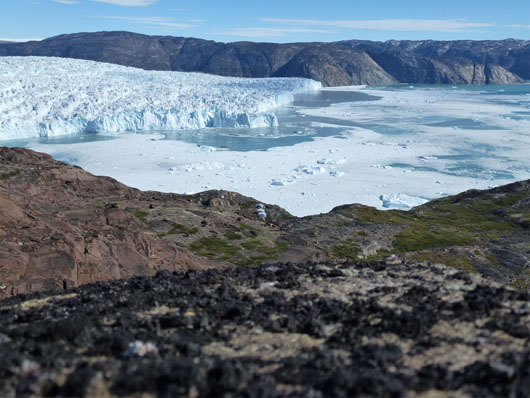Ice scientists study the birth of an iceberg

The moment of birth of an iceberg has been analysed in detail for the first time. A team of scientists from the University of St Andrews and Aberystwyth University has completed a detailed and thorough survey of the interface between a large marine-terminating glacier and the ocean.
Using a technique called side-scanning-sonar operated from their research vessel during July 2012, Dr Alun Hubbard and his team from Aberystwyth University mapped changes in the ice-front of Store Glacier on the West Coast of Greenland. This glacier is an outlet for the Greenland ice sheet.
Working with Alun Hubbard was Dr Richard Bates from the University of St Andrews who had developed new techniques of data processing that allowed him to compare the ice front before and after a massive iceberg calving event. This enabled him to visualise those changes in detail and make estimates of ice loss from the glacier front over a two-week period. This included an estimate of the mass of a single large iceberg that calved from the glacier, at almost 100 million tonnes.
The mapping revealed that the underwater section of the glacier front is an ice cliff 500 metres deep in places, at least four times higher than the section visible above water. Other features revealed by the scan included huge melt-water tunnels emerging at the base of the glacier and within the underwater face of the ice front, which Dr Hubbard believes are key to the mechanism by which large icebergs are formed.
The team, led by Dr Hubbard, had to sail their research vessel into the hazardous zone where icebergs collapse into the sea with devastating force. Icebergs can detach unexpectedly from the underwater section of the ice front, creating gigantic tsunamis as the ice rises to the surface. The team witnessed several such events during their work at Store.
For Dr Alun Hubbard and Dr Richard Bates, understanding the mechanisms through which icebergs are created is important for making predictions about changes in the amount of ice entering the world’s oceans as a result of climate change. Icebergs and melt-water from the Greenland ice sheet is making a direct contribution to global sea level rise, which some estimates place at a 1-to-2 metre rise by 2100. An increase in the number of icebergs is the North Atlantic may also disrupt shipping.
The team’s work was filmed as part of a documentary for the BBC, Operation Iceberg, which goes out at 9pm on BBC Two on Tuesday 30th October.
Ends
Images available on request including Dr Richard Bates’ scan images.
Contacts
For more information on Operation Iceberg, please contact Sheryl Holland on: 0208 225 8424, 07714 957007 or email [email protected]
Additional Operation Iceberg images available on request or from www.bbcpictures.co.uk
Additional contacts
For University of St Andrews enquiries please contact the University Press Office, [email protected], tel 01334 462530
For Aberystwyth University enquiries please contact Arthur Dafis, Swyddog Cyfathrebu Hyn / Senior Communications Officer at [email protected]
Category Research